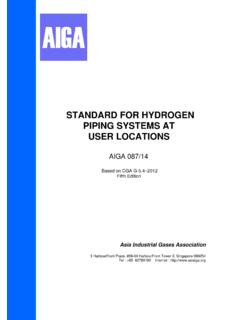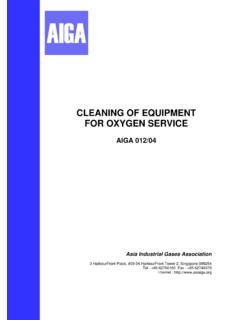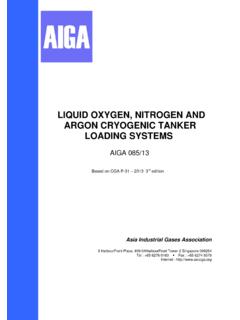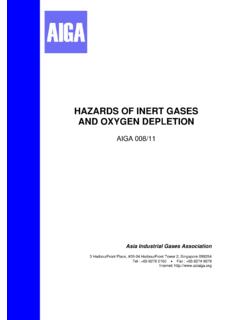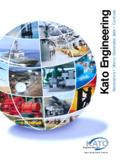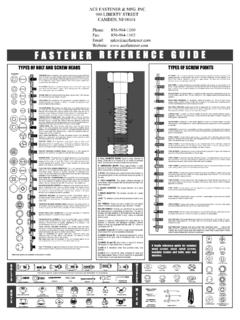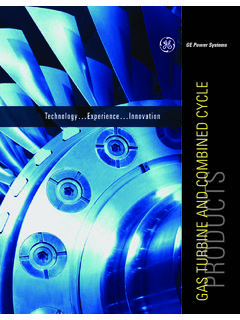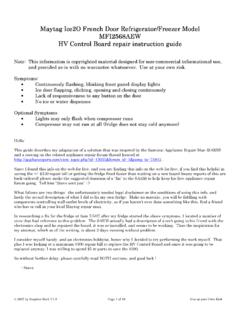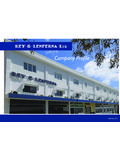Transcription of SAFE LOCATION OF OXYGEN AND INERT GAS VENTS - …
1 safe LOCATION OF OXYGEN AND INERT GAS VENTS AIGA 067/10 GLOBALLY HARMONISED DOCUMENT Asia Industrial Gases Association 3 HarbourFront Place, #09-04 HarbourFront Tower 2, Singapore 099254 Tel : +65 6276 0160 Fax : +65 6274 9379 Internet : Reproduced with permission from the European Industrial Gases Association. All rights reserved. ASIA INDUSTRIAL GASES ASSOCIATION 3 HarbourFront Place, #09-04 HarbourFront Tower 2, Singapore 099254 Tel: +65 62760160 Fax: +65 62749379 Internet: AIGA 067/10 GLOBALLY HARMONISED DOCUMENT safe LOCATION OF OXYGEN AND INERT GAS VENTS PREPARED BY: Roger Argent AIR PRODUCTS Lorenzo Beretta SOL Alfredo Delgado PRAXAIR Alexandre Morainville AIR LIQUIDE Harald Weckler LINDE GROUP Disclaimer All publications of AIGA or bearing AIGA s name contain information, including Codes of Practice, safety procedures and other technical information, that were obtained from sources believed by AIGA to be reliable and/or based on technical information and experience currently available from members of AIGA and others at the date of the publication.
2 As such, we do not make any representation or warranty nor accept any liability as to the accuracy, completeness or correctness of the information contained in these publications. While AIGA recommends that its members refer to or use its publications, such reference to or use thereof by its members or third parties is purely voluntary and not binding. AIGA or its members make no guarantee of the results and assume no liability or responsibility in connection with the reference to or use of information or suggestions contained in AIGA s publications. AIGA has no control whatsoever with regards to performance or non performance, misinterpretation, proper or improper use of any information or suggestions contained in AIGA s publications by any person or entity (including AIGA members), and AIGA expressly disclaims any liability in connection thereto.
3 AIGA s publications are subject to periodic review and users are advised to obtain the latest edition. AIGA 067/10 Acknowledgement This document is adopted from the European Industrial Gases Association document IGC 154/09 safe LOCATION of OXYGEN and INERT gas VENTS . Acknowledgement and thanks are hereby given to EIGA for permission granted for the use of the document. AIGA 067/10 Table of Contents 1 Introduction .. 1 2 Scope and 1 1 1 3 Definitions .. 1 Verbal forms .. 1 2 4 Hazards of OXYGEN enrichment or deficiency of the 2 5 Factors for consideration in the LOCATION of VENTS .. 3 General 3 Selection of concentration criteria for specific circumstances .. 4 Vent locations .. 4 Effect of weather and release 5 Venting of cryogenic 6 6 Calculations for the determination of safe vent locations .
4 6 Introduction .. 6 Choice of software .. 7 Weather conditions .. 7 Release temperature .. 7 Release angle .. 8 Release 8 Concentration limits .. 9 Ambient conditions .. 9 Interpretation of the tables .. 10 Limitations on the calculation 14 7 Conclusions .. 14 8 15 Appendix A: Warm Low Pressure Appendix B: Cold Low Pressure 19 Appendix C: Warm High Pressure Appendix D: Cold High Pressure 23 Appendix E: Warm Low Pressure Nitrogen ..24 Appendix F: Cold Low Pressure 27 Appendix G: Warm High Pressure Nitrogen ..30 Appendix H: Cold High Pressure 31 Appendix I: Warm Low Pressure 32 Appendix J: Cold Low Pressure Argon .. 34 Appendix K: Warm High Pressure 36 Appendix L: Cold High Pressure Argon .. 37 AIGA 067/10 APPENDIX M: Equivalent Release Rates.
5 38 APPENDIX N: Influence of Release Speed ..41 APPENDIX O: O2 Adjustment Mathematics .. 42 AIGA 067/10 11 Introduction This document defines the criteria for the design of process VENTS to ensure safe disposal of non-toxic, non-flammable gases. The industrial gas producers are subject to more and more stringent demands from authorities to demonstrate that the operation of their plants is safe . A number of accidents have been reported [1, 2] where enriched or deficient atmospheres from venting operations have created operational safety issues. As air separation unit capacity has increased the risk of OXYGEN enriched and deficient atmospheres has become a more significant safety concern. 2 Scope and purpose Scope This document applies to air separation and cryogenic liquefaction plants in which the venting of OXYGEN , nitrogen, OXYGEN /nitrogen mixtures, argon, or air occurs.
6 Disposal of cryogenic liquid is not covered in this document although the potential for vent releases to have some liquid present is included (Section ). The application of this document for non-flammable and non-toxic gases other than OXYGEN , nitrogen, argon, or air has to be assessed on a case-by-case basis. The recommendations contained in this document for elevations and horizontal separation distances are not applicable to customer station tanks. Safety distances for such tanks are governed by the design criteria for plant layout [3] or national regulations/codes of practice whichever are more stringent. Purpose This document is designed to give a basis on which to determine the safe LOCATION of OXYGEN or asphyxiating nitrogen and argon gas VENTS for normal operating, upset and emergency conditions.
7 The determination can be by calculation against the criteria specified or by use of the look-up tables provided in the document as a guide. The document contains calculated safe separation distances for a range of vent sizes and orientations based on commonly encountered but specific design conditions. If these design criteria are not met particularly with regard to VENTS intended to operate over a large range of flows ( product VENTS having turndown flows) the tables may not be appropriate and detailed calculations should be carried out. This document should be used for new designs but can be used on existing plants to determine whether existing VENTS are safely located or whether modifications/temporary structures will interfere with the original design intent.
8 3 Definitions Verbal forms Shall is used when conformance to a specific recommendation is mandatory. (French: doit ; German: muss ). Should indicates a recommendation to follow the specified procedure. (French: devrait ; German: sollte ). May is used when the application is optional. (French: peut ; German: darf , kann ). AIGA 067/10 Pressure In this document bar indicates gauge pressure unless otherwise noted , (bar, abs) for absolute pressure and (bar, dif) for differential pressure. 4 Hazards of OXYGEN enrichment or deficiency of the atmosphere OXYGEN , which is essential to life, is not flammable in itself but supports and accelerates combustion. OXYGEN reacts with most materials.
9 As the OXYGEN concentration in air increases the potential fire risk increases: the more vigorously the combustion reaction or fire takes place, the lower the ignition temperature and the ignition energy to get the combustion reaction started, and the higher the flame temperature and destructive capacity of the flame. If the OXYGEN concentration in air decreases, or (what amounts to the same) if the concentration of INERT gases increases, a situation is rapidly reached where the hazards of asphyxia become very great. Lack of OXYGEN may cause vertigo, speech difficulties but the victim does not recognise these symptoms as asphyxiation. For an unwary person, the asphyxiating effect of INERT gases takes place without any preliminary physiological sign that could alert the victim.
10 This action is very rapid: only a few seconds for very low OXYGEN contents. The hazards from OXYGEN enrichment or deficiency are explained in the AIGA documents Fire hazards of OXYGEN and OXYGEN enriched atmospheres [4] and Hazard of INERT gases [5]. The EIGA position paper Definitions of OXYGEN enrichment/deficiency safety criteria [6] provides the following guidance for selecting the appropriate level of OXYGEN for particular scenarios. The AIGA documents and the position paper state the measures that should be taken for a confined space entry. The maximum safe concentration for entry into a confined space that is being controlled or measured because of the risk is total O2. The minimum safe OXYGEN concentration for entry into a [confined] space that is being controlled or measured because of the risk is total O2.
